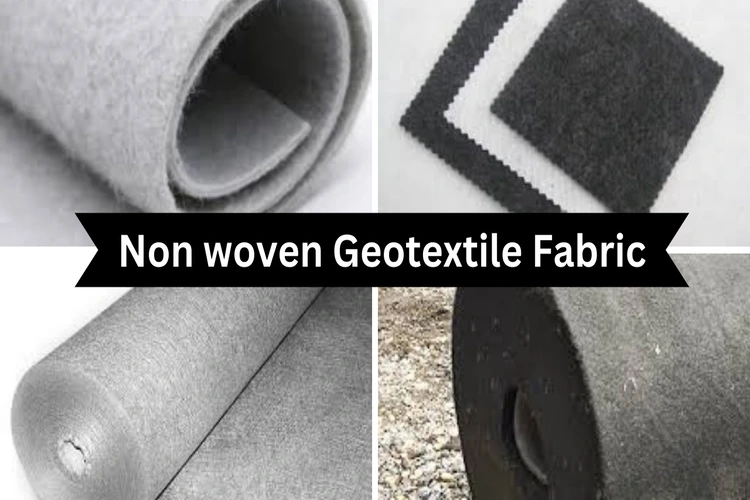What Is Non woven Geotextile Fabric?
Non woven geotextile fabric are crafted by bonding short and long fibers together, often through techniques like needle punching or other methods. Heat treatment is typically applied to boost the strength of these geotextiles. Made primarily from synthetic materials such as polyester or polypropylene, these geotextiles are permeable. They are well-suited for projects that necessitate protection, filtration, separation, and drainage. Nonetheless, they lack the durability of woven geotextiles.
Why we will use non woven Geotextile fabric?
In civil engineering, geosynthetic materials, particularly nonwovens, play a crucial role in geotextiles. Nonwoven materials fulfill diverse functions in construction, including separation, reinforcement, and filtration.
Non woven geotextile fabric are typically rolled out and are lightweight and easy to handle despite their robustness. They offer superior flexibility and mobility compared to woven geotextiles, making them ideal for separation tasks. Their thickness and resistance to punctures provide cushioning and safeguard geomembranes in various construction projects such as landfills, ponds, drainage systems, dams, river canals, coastal works, embankments, and mining designs.
Moreover, these materials are utilized in filtration and drainage applications because of their ability to filter out smaller particles while permitting water flow. They are well-suited for separating materials in paving applications for both asphalt and concrete roadways. Additionally, in barrier applications, nonwoven materials can function as a barrier against water infiltration.
Non woven geotextile fabric meet the stringent demands of challenging environments, boasting strength, tear resistance, puncture resistance, lightweight properties, and resilience to temperature fluctuations. The rapid progress of infrastructure projects has spurred a significant demand for nonwoven geotextiles across various sectors, including water conservancy, drainage systems, dams, river canals, coastal works, embankments, roads, highways, motorways, railway tracks, airfields, sports fields, and other sustainable projects. The unique flexibility of nonwovens in geotextiles makes them suitable for securing landfill infrastructure and for drainage and filtration applications in the textile industry.
Application of non woven geotextile fabric
Non woven geotextile fabric are made from either continuous filaments or staple fibers and find use in a variety of applications such as separation, reinforcement, filtration, drainage, and moisture barrier installation. These materials are utilized in infrastructure projects such as roads, railways, offshore land reclamation, roadside and railway embankments, river and canal banks, and embankments. Nonwoven geotextiles provide unique functionalities in geotechnical applications, serving purposes like filtration, drainage, separation, reinforcement, erosion control, and more.
Filtration
Non woven materials are used to trap fine soil particles, preventing them from being washed away by drainage elements. This method, pioneered in the mid-1960s, stands as one of the most common practices in geotextiles.
Separation
Non woven materials play a crucial role in geotextiles by separating layers of soil with different particle size distributions, preventing the migration of fine-grained subgrade soils into permeable granular road bases. This separation is essential for maintaining the structural integrity of various infrastructure projects, including roads, railroads, walls, dams, embankments, and barriers. By focusing on separation, nonwovens contribute to the long-term performance and stability of these structures.
Drainage
Geotextiles act as passive agents for moving liquids or gases, managing drainage independently. Yet, they are commonly paired with other components like drainage cores or perforated pipes. Needle-punched geotextiles are frequently merged with other materials to boost drainage capacity, creating what’s called drainage geocomposites.
Reinforcement
Geotextiles play a crucial role in reinforcement to bolster the load-bearing capacity of soft soils, a common practice in road engineering. Nonwovens aid in reducing stress levels within the foundation soil by distributing horizontal shear stresses caused by vertical loads. This mechanism disperses the load over a wider area, thus diminishing its impact. The primary goal is to mitigate vertical stress and lower the risk of failure.
Liquid barrier
The porous quality of non woven geotextile fabric allows them to absorb clay particles, which then occupy the open spaces within the fabric structure, effectively preventing the flow of liquids.
Erosion control
Non woven geotextile fabrics play dual roles as both separators and drainage layers. However, when their primary use is erosion control, they are classified separately. There is a substantial market potential for nonwoven geotextiles in soil erosion control.
Challenges in Non Woven Geotextile fabric
- Limited Awareness: Despite their advantages, geotextiles are often overlooked by many. Inadequate marketing efforts and a lack of understanding about non woven geotextile fabric products present significant hurdles for the textile industry.
- Shortage of Skilled Labor: Manufacturing geotextiles involves various complex processes, requiring a highly skilled workforce. However, there is currently a shortage of trained professionals in the geotextile sector.
- Insufficient Research and Development: The geotextiles industry struggles with limited product diversification due to a lack of focus on research and development. Innovation is essential for progress in this field, but the textile industry faces challenges in advancing research and development endeavors.
You may also like:
- Count of Yarn: Explanation and Varieties
- Varieties of Woven Fabrics and Their Applications
- Yarn Manufacturing Process
- What is Hemp Fiber? Properties, Advantages and Disadvantages.
- Buckram Fabric Guide, Applications, and Varieties
- What is Sisal Fiber? Properties, Structure, and How It Made?
- Pina Fiber: History, Properties, Production Process
- Coir Fiber: Properties, Production Process and Advantages
Share this Article!

